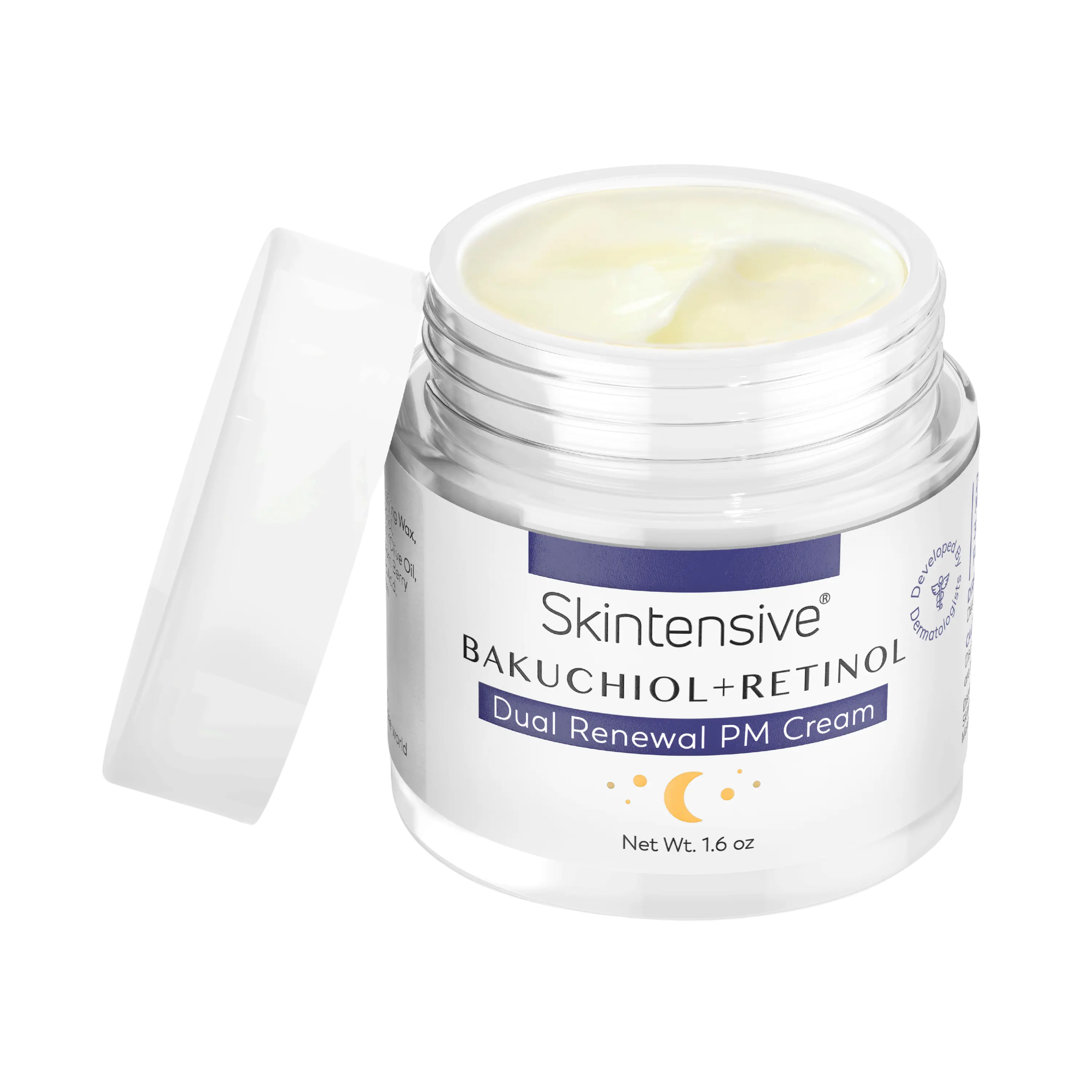Have you ever noticed unexplained red or brown patches on your lower legs? These could be symptoms of a condition known as capillaritis, which includes various types such as Schamberg's disease and pigmented purpura. Understanding the causes, symptoms, and management of capillaritis is crucial to effectively address these harmless but bothersome skin conditions.
Throughout this article, we will explore the most common type of capillaritis, delve into the intricacies of Schamberg's disease and pigmented purpura, and discuss differential diagnoses. Additionally, we will consider treatment options, including topical creams, light therapy, and vascular laser treatments.
Introduction to Pigmented Purpura, Capillaritis, and Schamberg's Disease

Photo: Patient produced photo of capillaritis/Schamberg's disease before and after application of Skintensive Bruise Cream twice a day for 6 months.
Pigmented purpura, capillaritis, and Schamberg's disease are skin conditions characterized by the appearance of red or purple patches on the skin. They fall under the umbrella term of capillaritis, which refers to the inflammation and leakage of small blood vessels in the skin.
Capillaritis manifests in various forms, each with distinct clinical features and underlying causes. Some of the common types discussed in this article include Schamberg's disease, Doucas-Kapetanakis eczematid-like purpura, Gougerot-Blum purpura, Majocchi purpura, and Lichen aureus.
Schamberg's disease, also known as progressive pigmented purpura, is the most common type of capillaritis. It typically affects the lower legs and presents as brownish-red patches, often with a cayenne pepper-like appearance. Other forms of capillaritis may manifest as itchy purpura, purpuric lichenoid dermatosis, or annular patches.
Although capillaritis is a benign condition, it can be distressing for individuals experiencing symptoms such as burning sensations or cosmetic concerns. Unfortunately, there is no known cure for capillaritis, but management options may include topical corticosteroids, ascorbic acid supplements, or light therapy.
Throughout this article, we will delve deeper into the different types of capillaritis, exploring their clinical features, causes, diagnostic methods, and available treatment options. So, let's embark on this journey to gain a comprehensive understanding of pigmented purpura, capillaritis, and Schamberg's disease.
Capillaritis
Capillaritis is a skin condition characterized by inflammation of the small blood vessels near the skin's surface. It typically presents as flat red or purple patches, often on the lower legs. Capillaritis can be divided into different types, each with its own set of clinical features and characteristics. Understanding the various types of capillaritis is crucial for accurate diagnosis and appropriate management.
What is capillaritis?
Capillaritis refers to the inflammation of the capillaries, which are the smallest blood vessels in the body. These tiny vessels play a significant role in the exchange of oxygen and nutrients between the blood and surrounding tissues. When capillaries become inflamed, they may leak red blood cells into the surrounding tissues, leading to the characteristic red or purple patches seen in capillaritis.
What Does Capillaritis Look Like?
Capillaritis presents as flat, reddish-brown patches on the skin. These patches may be accompanied by a burning sensation or itching in some cases. The most common type of capillaritis is Schamberg disease, which is characterized by brown dots or cayenne pepper spots on the lower legs.
What causes capillaritis?
The exact cause of capillaritis is not fully understood. However, certain factors are believed to contribute to its development. These include:
- Venous stasis: Capillaritis can be associated with poor blood flow in the veins, particularly in the lower legs. This can occur due to conditions like varicose veins or prolonged standing.
- Inflammation and injury: Inflammatory reactions or physical trauma to the skin can trigger capillaritis. This includes certain skin conditions, allergies, or vigorous exercise.
- Medications and chemicals: Some medications, such as topical steroids, can cause capillaritis-like skin changes. Exposure to certain chemicals or additives, like cayenne pepper or food preservatives, may also contribute to capillaritis.
What are the different types of capillaritis?
Capillaritis encompasses several different types, each with its own distinctive clinical features and characteristics. Some of the most common types include:
- Schamberg disease (progressive pigmented purpura): This is the most frequently encountered form of capillaritis. It presents as brownish-red patches on the lower legs and may be associated with a burning sensation or itching.
- Doucas-Kapetanakis eczematid-like purpura: This variant of capillaritis is characterized by small, itchy red patches that resemble eczema. It commonly affects the lower legs and can be triggered by warm weather or exercise.
- Gougerot-Blum purpura (pigmented purpuric lichenoid dermatosis): In this type, flat red patches with a brownish hue are seen on the lower legs. It is often asymptomatic but can occasionally cause itching or discomfort.
- Majocchi purpura (purpura annularis telangiectodes): This form of capillaritis is characterized by large, annular patches with a purple or reddish-brown color. It typically affects the lower legs and may be associated with a burning sensation.
How can capillaritis be diagnosed?
Diagnosing capillaritis involves a combination of clinical evaluation, patient history, and occasionally, further investigations. A healthcare professional will examine the characteristic skin lesions and inquire about any associated symptoms or triggers. In some cases, a skin biopsy may be performed to confirm the diagnosis and rule out other potential causes.
How can capillaritis be treated?
Capillaritis is usually diagnosed clinically based on the characteristic appearance of the skin lesions. In some cases, a skin biopsy may be performed to confirm the diagnosis.
Treatment for capillaritis aims to manage symptoms and improve the appearance of the skin. Options may include topical corticosteroids, topical calcineurin inhibitors, compression stockings, and laser therapy. However, capillaritis does not have a known cure, and the condition may persist despite treatment. Skintensive Bruise Cream, a cold pressed arnica and vitamin K moisturizing formula has been used successfully to revitalize the appearance of skin affected by capillaritis (see photo above)
Consultation with a dermatologist is recommended for an accurate diagnosis and to discuss the appropriate treatment options for capillaritis.
Schamberg Disease
Schamberg Disease, also known as progressive pigmented purpura, is a common type of capillaritis that affects the lower legs. It is characterized by the appearance of brownish-red patches, often in a cayenne pepper-like pattern. This chronic condition is more common in young adults and may cause mild symptoms such as itching, burning sensation, or discomfort in some cases.
Affiliations
Schamberg Disease is often associated with other medical conditions, such as venous stasis, varicose veins, or mycosis fungoides. It has also been linked to certain factors including warm weather, vigorous exercise, or the use of certain medications or topical corticosteroids.
Objectives
When diagnosing Schamberg Disease, distinguishing it from other similar conditions is crucial. A thorough evaluation, including a detailed medical history and physical examination, can help identify the distinctive features associated with this condition. Skin biopsy may be performed to confirm the diagnosis by examining the skin under a microscope.
Etiology
The exact cause of Schamberg Disease is still unknown. It is believed to be related to the extravasation of red blood cells from small blood vessels into the surrounding skin, leading to the characteristic purpuric dermatosis. Some experts suggest that inflammation or a reaction to certain agents may play a role in triggering the condition.
Epidemiology
Schamberg Disease is considered a benign and harmless skin condition. It is more prevalent in males and typically occurs in individuals between the ages of 10 and 40. Although it can affect people of all ethnicities, it seems to be more common in those with fair or light skin.
Pathophysiology
The pathophysiology of Schamberg Disease involves the leakage of red blood cells from the capillaries into the skin, resulting in the deposition of hemosiderin. This deposition causes the characteristic reddish-brown patches seen in affected individuals. The exact mechanisms behind this leakage are not fully understood.
Histopathology
Histopathological examination of a skin biopsy from a lesion of Schamberg Disease typically reveals red blood cells extravasation, hemosiderin deposits, and mild inflammation within the skin's small blood vessels. These findings confirm the diagnosis of this capillaritis condition.
History and Physical
Schamberg Disease is diagnosed based on its clinical features. The skin lesions appear as flat red patches that may merge together, forming larger areas. These patches are often asymptomatic, although some individuals may experience mild itching or burning sensation. The lesions usually affect the lower legs symmetrically.
Evaluation
To diagnose Schamberg Disease accurately, a comprehensive evaluation is required. This typically involves a thorough medical history, physical examination, and sometimes a skin biopsy. Other diagnostic tests, such as blood tests, may be recommended to rule out any underlying medical conditions that could contribute to the development of the skin lesions.
Treatment / Management
Currently, there is no known cure for Schamberg Disease, and treatment mainly focuses on managing symptoms and preventing the progression of the condition. Topical corticosteroids or tacrolimus may be prescribed to reduce inflammation and improve the appearance of the skin. In some cases, laser therapy or light therapy may be utilized to target the affected blood vessels and reduce visible skin changes. Skintensive Bruise Cream, a cold pressed arnica and vitamin K moisturizing formula has been used successfully to revitalize the appearance of skin affected by capillaritis (see photo above)
Differential Diagnosis
When evaluating the skin lesions associated with Schamberg Disease, healthcare professionals should consider other conditions that present with similar clinical features, such as contact dermatitis, lichen planus, or purpura caused by other underlying medical conditions. A comprehensive differential diagnosis is essential to ensure an accurate diagnosis and appropriate management.
Prognosis
Schamberg Disease is generally a chronic and benign condition that tends to persist over time. The prognosis is typically favorable, with many individuals experiencing minimal or no symptoms. However, the appearance of the skin lesions may cause cosmetic concerns for some patients. Regular monitoring and management strategies can help control symptoms and maintain an optimal quality of life.
Disclaimer:
The content in this article is not medical advice, but rather informational content. As a service to our readers, Skintensive provides access to our library of archived blog content. Please note the date of last review or update on all articles. No content on this site, regardless of date, should ever be used as a substitute for direct medical advice from your doctor or other medical professional.







